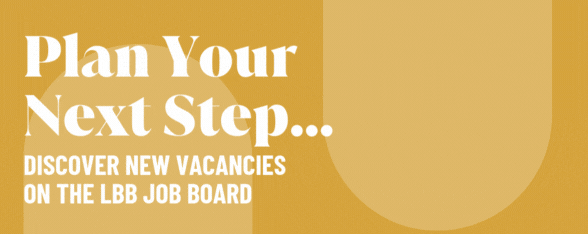
The New New Business: Act Like You've Already Won with Sandy Cuesta

Sandy Cuesta has over a decade of driving the new business process and leading marketing efforts across thought leadership creation, event execution, PR and media coordination and social strategy. Prior to Wolff Olins, Sandy has worked at other global brand consultancies such as Lippincott and Interbrand. She also worked client side at PwC supporting global priority accounts in entertainment and media, and in the pharma, tech, and biotech sectors. Sandy is passionate about championing DE&I efforts and has served on the board of non-profit organizations driving more equity and inclusion in the brand, tech, and design world. She is an ambassador for Women In Innovation and she has supported TEDx event efforts. Sandy is a native Spanish speaker, small business owner, and a novice UX researcher and designer.
LBB> What was your first sale or new business win?
Sandy> I don’t recall my first new business win, but one that taught me a lot early on was a pitch to rebrand a heritage clothing brand that had ambitions to scale across geographies, double down on their commitment to sustainable fashion, and win over younger, more street savvy customers. We did ‘store safaris’, interviewed customers and employees, and brainstormed activation ideas for how the new brand could come to life. We worked nights and weekends for weeks, writing and rewriting the pitch narrative countless times, creating mood boards and brand worlds to excite the prospects around what their potential future could look like. We even took the design that we developed and applied it to product prototypes, spending a night in the studio literally printing branded T-shirts. It was the one of the most creatively rewarding experiences of my life, because I learned something truly valuable: to win a dream client, you have to show them you’re already fully committed to their team. Like you’re kicking off the first phase. You have to act like you’ve already won.
LBB> What was the best piece of advice you got early on?
Sandy> A former boss at one of my prior companies is an incredible storyteller. She was a writer turned marketer turned new business professional, so she brought a whole new, more emotive approach to pitches and new business. She knew the art of storytelling. The right story can create the right emotional connection with your audience. The right anecdotes make your pitch much more memorable. I’m so grateful to have gotten the chance to learn from her. Pushing the story is something I continue to encourage myself and my teams to embody in every pitch.
LBB> And the worst?
Sandy> “Just repurpose the prior deck and replace the client name.” Nope. Clients can see right through it. We always address each client’s individual challenges, opportunities and ambitions. Just as there’s no templated approach to creating a new brand, there's no templated approach for a pitch either.
LBB> How has the business of ‘selling’ in the creative industry changed since you started?
Sandy> The business is more competitive than ever, especially in a world where most pitching takes place behind screens. It’s difficult to bring the magic to the room when there is no physical room anymore. In these times, building moments of chemistry is more vital than ever. We try to incorporate the client as much as possible so we’re not talking to them, but encouraging active participation in a two-sided conversation so we’re co-creating the right solution together.
LBB> Can anyone be taught to sell or do new business or do you think it suits a certain kind of personality?
Sandy> I think it takes a certain personality to work in new business - you have to learn to bounce back really quickly from loss, be persistent, and most of all, you have to be the right kind of partner. Rarely do clients want to work with big egos; they want to work with people they’d enjoy being in the trenches with, day in and day out. It takes someone who is willing to build an authentic relationship, and is in it for the long haul.
LBB> What are your thoughts about the process of pitching that the industry largely runs on? (e.g. How can it be improved - or does it need done away with completely? Should businesses be paid to pitch? What are your thoughts about businesses completely refusing to engage in pitching? How can businesses perform well without ‘giving ideas away for free?)
Sandy> This is a tough one because I can see both sides. I appreciate organisations are now creating more paid pitch opportunities, because it shows that leadership is committed to finding the right partner. We tend to operate in the middle, we don’t go the whole way by solving the challenge during the pitch stage, and that’s mostly because we want to do the right kind of research and immersion into the business before we can give the right recommendation. But we also tend to be provocative by teasing them with where we think the opportunity lies based on what we know to date. We try to go a bit deeper too, by doing desktop research, competitive audits, and interviewing clients and prospects. Clients know it's not the final answer but appreciate that you did your homework.
LBB> How do you go about tailoring your selling approach according to the kind of person or business you’re approaching?
Sandy> Understanding what your prospect is expecting and anticipating their needs is key. We start by understanding who we’re connecting with by looking at the role they’re in, what their responsibilities are, and where they worked previously. Then we try to dissect what challenges they might be facing and how we can help them overcome those. Before a big pitch, we try to anticipate the questions that the prospect might have for us, so we’re well prepared for those in advance.
LBB> New business and sales can often mean hearing ‘no’ a lot and quite a bit of rejection - how do you keep motivated?
Sandy> The way we stay motivated is by continuing to build up our pipeline with dream clients we’re into and of course, learning from our losses. We usually hold calls to understand why we weren’t selected and then we ensure we’re taking those learnings into the next pitch. One thing that helps keep the motivation is knowing that if you gave it your all and if the prospect is appreciative of that, chances are you’ll be able to re-engage with them at some point in the future.
LBB> The advertising and marketing industry often blurs the line between personal and professional friendships and relationships… does this make selling easier or more difficult and delicate?
Sandy> I think it’s a lot easier to sell into warm contacts so I would say building professional relationships and friendships is key. Many times it’s easier to secure the first meeting by having a direct connection or by having someone make an introduction. I’ve become running buddies with one of my past clients, and I’ve gotten invited to gallery openings by another.
LBB> In your view what’s the key to closing a deal?
Sandy> Show that you want it. More than anyone else. Approach every meeting exceeding expectations. Always close the meeting emphasizing how much you want it. And be willing to flex if needed. Rarely is the final pitch or proposal the final submission, there are usually a few more conversations to be had to ensure the partnership is the right fit on both sides.
LBB> How important is cultural understanding when it comes to selling internationally? (And if you have particular experience on this front, what advice do you have?)
Sandy> Understanding cultural nuances is super important, but avoid generalizations or stereotypes. Doing a bit of research on how business is conducted is useful, as well as engaging with someone who has done business in that country in the past. I’d also avoid using corporate jargon when communicating abroad. The simpler you are in how you talk about your services and products, the easier it’ll be for any prospect to understand what you’re selling them.
LBB> How is technology and new platforms (from platforms like Salesforce and Hubspot to video calls to social media) changing sales and new business?
Sandy> Salesforce has made it so much easier to maintain client contacts and update key meetings but actually, Winmo has been a tool that has helped us a ton. It automatically updates us when a key contact has moved to another company and it even provides personality profiles for certain clients based on other people’s notes on them. I’m also a huge Mural fan when it comes to whiteboarding ideas with clients in real time.
LBB> There’s a lot of training for a lot of parts of the industry, but what’s your thoughts about the training and skills development when it comes to selling and new business?
Sandy> The best training comes from being in the trenches day in and day out, only then will you get to know what selling approach works best for you. There isn’t a codified method. I’ve found that picking different mentors has helped me shape the way I approach it. I've picked up certain qualities I admire from them and merged them with my own authentic style.
LBB> What’s your advice for anyone who’s not necessarily come up as a salesperson who’s now expected to sell or win new business as part of their role?
Sandy> There is no magic way to close a deal - it all depends on the prospect, so you’re going to have to get creative and find a way to bring more value at every touchpoint. At a previous company, my team and I once secured a client because we saw that the prospect was raising money to purchase books for schools in their community. Our team decided to boost his efforts by raising money on our own to donate to his fundraiser and the rest was history.















